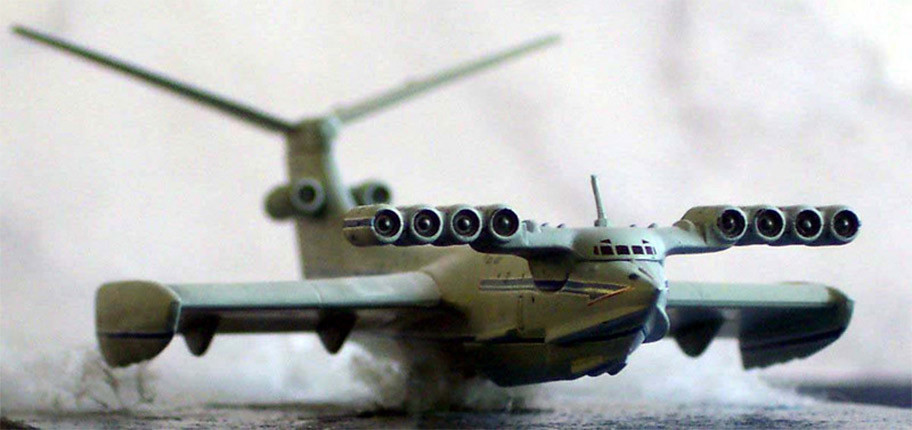Deputy Prime Minister of Russia Yury Borisov told reporters that the State Program of Armament for 2018-2027 envisages the development of a prototype of the ekranoplan "Orlan". According to him, the newest aircraft will be able to carry missile weapons.
As Borisov said, "Orlans" will be used to protect the Northern Sea Route (NSR) and the "inner seas" of the Russian Federation. Also, the aircraft will participate in search and rescue operations.
"The main functional for him is the Northern Sea Route, where our infrastructure is not very developed, he can barrage, close these areas. Inland seas too: the Caspian Sea, the Black Sea, "- said the Deputy Prime Minister.
«Screen effect»
The Ekranoplan is a multipurpose vessel on a dynamic air cushion. As a rule, the device flies at a height of about a meter from the water surface at a speed of up to 500 km / h. This mode creates a "screen effect", in which the compression of air increases the lifting force.
Using the energy of the oncoming stream, the ekranoplan is able to overcome distances without significant fuel costs, proving to be a more economical means of transportation than an airplane and a helicopter. In addition, flying at such a low altitude makes the ship virtually invisible to the enemy's radar equipment.
"The Ekranoplan is a cross between an airplane and a ship. The device travels much faster than any vessel whose maximum speed rarely exceeds 30 knots (55 km / h). Moreover, it is even visually less noticeable than the most modern aircraft, "Dmitri Drozdenko, a columnist for the Arsenal of the Fatherland magazine, said in an interview with RT.
As explained by the expert, in the Navy ekranoplan can be used to deliver unexpected strikes on aircraft carrier groups or to deliver troops. The ship's capabilities allow him to stealthily get close to the enemy and after launching ammunition much faster than the ship to leave the firing position and the zone of defeat.
The shortcomings of ekranoplanes include the limitations associated with sea waves, and lack of maneuverability. The common problem of ekranoplanes is longitudinal instability. It is expressed in the fact that when the altitude is changed, the center of application of the lifting force is displaced. The bow of the ship behaves unstably and can touch the water surface or, on the contrary, it can rise too high.

- Rocket ship-ekranoplan of project 903 "Lun"
- © belayaistoriya.ru
"The Ekranoplan has limitations on the mass of weapons that it can take on board. Obviously, such a device can not be placed, for example, the Caliber complex. However, modern industry is able to create for him an easy and powerful weapon, "Drozdenko said.
"Eaglet" and "Lun"
Work on ekranoplans began in the Soviet Union in the 1950s. The flagship of the design idea was TsKB. Alekseeva (Nizhny Novgorod). For more than 65 years, the company has been building ships on air cushions and underwater wings.
In 1979 the landing craft-ekranoplan of project 904 "Orlyonok" was adopted for the Navy. In total, four ships were built. The USSR Ministry of Defense planned to equip the fleet with 120 "Eaglets", but later these plans were revised.
On July 16, 1986, a prototype of the 905 Lun missile project was launched. The vessel was tested in the Caspian Sea. The eight-unit engine could accelerate to 500 km / h and act in a six-point storm.
"Lun" was completely unlike any of the types of air and sea technology. The vessel was struck by its bizarre outlines and dimensions (length - 73 m, height - 19 m). To attack the enemy, the ekranoplan was equipped with anti-ship anti-ship missiles ZM-80 "Moskit" with a range of 120-250 km.
In 1990, the Navy began pilot operation of the "Lunya", but it was not possible to replenish the fleet with unique airplanes. An unusual machine, like any modern technology, needed to eliminate "childhood diseases" (the military complained of weak reliability) and in additional tests.
"After the collapse of the Soviet Union, the Navy entered a period of reduction. Russia refused to have large surface ships, and, naturally, there were no funds for the development of the impact ekranoplan. However, "Lun" could benefit the country's defense capability. In the United States, they did not hide the joy of closing the project of the Caspian monster, Drozdenko stated.
Guarding the Arctic
Discussions on the revival of the Navy ekranoplan continue for the past four years. One of the first about the need to restore its production for military needs was stated by Vladimir Gutenev, First Deputy Chairman of the State Duma Industry Committee in August 2014.
In July 2017, Igor Ponomaryov, Vice President of the United Shipbuilding Corporation (USC) for military shipbuilding, announced the readiness of the domestic industry to start developing an ekranoplan for the Navy.
Since 1990, Russian enterprises produce only civilian vessels. One of the breakthrough projects is the new-generation ekranoplan "Chaika" A-050 with a displacement of 54 tons and a payload of 15 tons.

- Ekranoplan A-90 "Eaglet"
- © Wikimedia
It is assumed that the first machine will be assembled in 2019-2020. The Ekranoplan can be used, including by power departments of the Russian Federation for delivery of cargoes and personnel transportation.
As suggested by Drozdenko, TsKB them. Alekseeva retained the scientific and technological potential for the creation of a shock ekranoplan. According to him, Nizhny Novgorod engineers are able to meet the requirements of the Ministry of Defense to the project equipped with missile weapons "Orlan".
"Given the current technological possibilities, I would venture to assume that the Russian WIG craft will be inferior in size to its Soviet counterpart and unambiguously surpass it in combat power. In the arsenal of "Orlan" can be hypersonic missiles "Zircon". The ship will become a threat to the US Navy and will serve Russia primarily in the protection of the Arctic spaces, "Drozdenko said.
